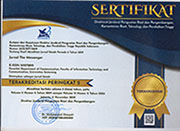Consuming Representations of Korean TV Dramas among Indonesian Muslim Youth
Abstract
This article dealt with Korean TV dramas consumption among Muslim youth in Pekanbaru. It aimed to undestand their interpretations on the television dramas. The values of being a Muslim was constantly under scrutiny by the image representation in Korean TV Dramas. As transnational cultural products, they were considered as reducing Islamic values for Muslim youth. Using ethnographic study, forty two informants were selected based on a purposive sampling technique in which they loved on consuming Korean TV dramas. This article found that Muslim youth were active audiences consuming and interpreting Korean TV dramas. This can be seen from two characteristics. The first is that Muslim youth consumption of Korean TV dramas was not dominantly done through television medium, but through their lapptop. As a result, their position as an active audiences or viewers was obvious. This was because the dramas to be watched were not interrupted by some advertisements. The audiences could also actively watch them without depending on the schedule decided by television stations. The second is that young Muslims watching Korean TV dramas did not accept some representations contradictory with their Islamic identity. However, some of Korean TV dramas were accepted due to their proximity with Islamic values.
Keywords
Full Text:
PDFReferences
Ahn. (2014). China s post 80s and 90s generation and selective reception of foreign popular culture: The case of Beijing. The Journal of the Korea Contents Association, 14(6), 34 43.
Ang, I. (1991). Desperately Seeking the Audience. Routledge.
Appadurai, A. (1988). The Social Life Of Things: Commodities In Cultural Perspective. Camb.
Barker, C. (2000). Cultural Studies : Theory and Practice. Sage.
Berg, S.-H. (2015). Creative Cluster Evolution: The Case of the Film and TV Industries in Seoul, South Korea. European Planning Studies, 23(10), 1993 2008. https://doi.org/10.1080/09654313.2014.946645
Chen, L. (2017). The emergence of the anti-Hallyu movement in China. Media. Culture & Society, 39(3), 374 390. https://doi.org/10.1177/0163443716646176
Cho, Y., & Zhu, H. (2017). Interpreting the television format phenomenon between South Korea and China through inter-Asian frameworks. International Journal of Communication, 11, 2332 23491.
Chuang, L. M., & Lee, H. E. (2013). Korean wave: Enjoyment factors of Korean dramas in the U.S. International Journal of Intercultural Relations, 37(5), 594 604.
Effendi, R. (2010). Riau Al-Munawarah : Menuju Masyarakat Madani untuk Mewujudkan Visi Riau 2020. Pustaka Pelajar.
Febriana, K. A., Setiawan, Y. B., & Ersyad, F. A. (2019). Warak Ngendhog Commodification as a Kind of Creative Industry in Semarang City. Jurnal The Messenger, 11(1), 27. https://doi.org/10.26623/themessenger.v11i1.925
Fleur, D., & Rokeach, B. (1989). Theories of Mass Communication. Longman.
Han, B. M. (2019). Fantasies of Modernitiy : Korean TV Dramas in Latin America. Journal of Popular Film and Television, 47(1), 39 47. https://doi.org/DOI:10.1080/01956051.2019.1562823
Huang, S. (2011). Nation-branding and transnational consumption: Japan-mania and the Korean wave in Taiwan. Media, Culture & Society, 33(1), 3 18. https://doi.org/10.1177/0163443710379670
Huat, C. B. (2012). Doing pop culture studies in East Asia. In Z. Ibrahim (Ed.), Social Science in a Globalising World (pp. 323 344). SIRD and PSSM.
Ida, R. (2008). Consuming Taiwanese Boys Culture : Watching Meteor Garden with Urban Kampung Women. In A. Heryanto (Ed.), Popular Culture in Indonesia : Fluid Identities in Post-Authoritarian politics. Routledge.
Jang, K. (2019). Between Soft Power and Propaganda: The Korean Military Drama Descendants of the Sun. Journal of War & Culture Studies, 12(1), 24 36. https://doi.org/10.1080/17526272.2018.1426209
Jeong, J. S., Lee, S. H., & Lee, S. G. (2017). When Indonesians Routinely Consume Korean Pop Culture: Revisiting Jakartan Fans of Korean Drama. Dae Jang Geum, 11, 2288 2307.
Jiang, Q., & Leung, L. (2012). Lifestyles, gratifications sought, and narrative appeal: American and Korean TV drama viewing among Internet users in urban China. Communication Gazette, 74(2), 159 180. https://doi.org/10.1177/1748048511432601
Jin, B., & Jeong, S. (2016). The impact of Korean television drama viewership on the social perceptions of single life and having fewer children in married life. Asian Journal of Communication, 21(1), 17 32. https://doi.org/DOI: 10.1080/01292980903440806
Ju, H. (2017). National television moves to the region and beyond: South Korean TV drama production with a new cultural act. The Journal of International Communication, 23(1), 94 114. https://doi.org/10.1080/13216597.2017.1291443
Ju, H., & Lee, S. (2015). The Korean Wave and Asian Americans: the ethnic meanings of transnational Korean pop culture in the USA. Continuum, 29(3), 323 338. https://doi.org/: 10.1080/10304312.2014.986059
Jung, H. (2019). Agenda-setting in the realm of popular culture: The case of the Korean Wave in East Asia. Global Media and Communication, 15(3), 361 377. https://doi.org/10.1177/1742766519872782
Kang, J. (2016). A study on the perspectives of Chinese media on Korean Wave. The Journal of Chinese Studies, 75, 301 321.
Kim, S., & Wang, H. (2012). From television to the film set: Korean drama Daejanggeum drives Chinese, Taiwanese, Japanese and Thai audiences to screen-tourism. International Communication Gazette, 74(5), 423 442. https://doi.org/10.1177/1748048512445152
Kim, E., & Kim, S. (2016). Japanese and Chinese journalists views on anti-Korean Wave. Journal of the Korea Contents Association, 37(1), 69 83. https://doi.org/10.1080/07256868.2015.1119810
Kim, S. (Sam), Kim, S. (Sean), & Heo, C. (Yoonjoung). (2015). Assessment of TV Drama/Film Production Towns as a Rural Tourism Growth Engine. , Asia Pacific Journal of Tourism Research, 20(7), 730 760. https://doi.org/10.1080/10941665.2014.927378
Lee, C. S. (2015). Korean Media Products Inside and Outside South Korea : Localised, Regionalised and Globalised Cross-Border Production in Asia. In J. Ainslie & J. B. . Lim (Eds.), Korean Wave in Southeast Asia: Consumption and Cultural Production (pp. 15 29). SIRD.
Lu, J., Liu, X., & Cheng, Y. (2019). Cultural Proximity and Genre Proximity : How Do Chinese Viewers Enjoy American and Korean TV Dramas. Sage Open, 9(1), 1 10. https://doi.org/10.1177/2158244018825027
Man Ng, T., & Shing Chan, C. (2020). Investigating film-induced tourism potential: the influence of Korean TV dramas on Hong Kong young adults. Asian Geographer, 37(1), 53 73. https://doi.org/10.1080/10225706.2019.1701506
Marris, P., & Thomham, S. (2005). From Effect to Uses : Introduction. In Media Studies : A Reader. Edinburg University Press.
Milestone, K., & Meyer, A. (2012). Gender and Popular Culture. Polity Press.
Oh, I. (2013). he globalization of K-pop: Korea s place in the global music industry. Korean Observer, 44(3), 389 409.
Park, J. H., Lee, Y. S., & Seo, H. (2019). The rise and fall of Korean drama export to China: The history of state regulation of Korean dramas in China. International Communication Gazette, 81(2), 139 157. https://doi.org/10.1177/1748048518802915
Pawanteh, L. (2005). In Search of Cultural Resemblance : The Consequences of Media Consumption among Young Adults in Malaysia. 14th AMIC Annual Conference on Media and Society in Asia : Transformations and Transition.
Shao, L. (2020). The returning of Hallyu in China: transnational reception of the Korean drama My Love from the Star. Media International Australia, 175(1), 79 92. https://doi.org/10.1177/1329878X19882530
Storey, J. (2003). Cultural Studies and the Study of Popular Culture. Edinburg University Press.
Tambunan, S. (2015). Imaginary Asia: Indonesian audience s reflexity on K-dramas. In. In M. J. Ainslie & J. B. . Lim (Eds.), The Korean Wave in Southeast Asia: Consumption and Cultural Production. SIRD.
Willis, P. (1998). Symbolic creativity. In Cultural Theory and Popular Culture: A Reader. Prentice Hall.
Yang, J. (2012). The Korean Wave (Hallyu) in East Asia: A Comparison of Chinese, Japanese, and Taiwanese Audiences Who Watch Korean TV Dramas. Development and Society, 41(1), 103 147. www.jstor.org/stable/deveandsoci.41.1.103
Yecies, B. (2016). The Chinese Korean co-production pact: collaborative encounters and the accelerating expansion of Chinese cinema. International Journal of Cultural Policy, 22(5), 770 786. https://doi.org/, DOI: 10.1080/10286632.2016.1223643
Yoon, K., & Jin, D. Y. (2016). The Korean Wave Phenomenon in Asian Diasporas in Canada. Journal of Intercultural Studies, 31(1), 69 83. https://doi.org/10.1080/07256868.2015.1119810
Yoon, K., Min, W., & Jin, D. Y. (2020). Consuming the Contra-Flow of K-pop in Spain. Journal of Intercultural Studies, 41(2), 132 147. https://doi.org/1
DOI: http://dx.doi.org/10.26623/themessenger.v12i2.2115
Refbacks
- There are currently no refbacks.
Copyright (c) 2020 Jurnal The Messenger
View My Stats [Jurnal The Messenger] is an International Scientific Journal, Published by the Department of Communication, Faculty of Information Technology and Communication, Universitas Semarang (Central Java, Indonesia). It is licensed under a Creative Commons Attribution 4.0 International License.



_11.jpg)




_BARCODE.jpg)
_BARCODE1.jpg)


5.png)










2.png)





